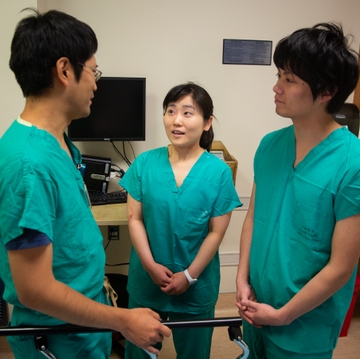Program Provides Research Opportunities for Undergraduate Students

Emergency Exchange
Young Japanese Doctors Visit UNM Hospital
Kimiko Sato and Satoru Meguro, third-year medical residents at Sendai City Hospital in Japan, have visited the United States before. They've both seen the Grand Canyon - and he's even been to New York City.
But they both looked a little stunned as they toured the UNM Hospital emergency department Thursday morning. Eighty-two of 83 exam rooms were already full and a trauma team was hard at work resuscitating an unconscious patient.
Tatsuya Norii, MD, assistant professor in the Department of Emergency Medicine, assured the pair that things would only get busier as the day progressed, and predicted they would see patients with gunshot wounds before their shift ended.
That impressed them. In Japan, Norii explained, there have been fewer than 50 gunshot victims in the entire country over the past decade. Japanese doctors are also unlikely to see cases of drug overdose, snakebite, hantavirus or plague - all of which are disturbingly common in New Mexico.
"I think we are very safe," Sato said. Then again, the Japanese face some hazards New Mexicans seldom encounter. She was a young medical student when the Tohoku earthquake and tsunami struck northeastern Japan in 2011, killing nearly 20,000 people. Sato helped in the grim task of identifying decomposed bodies using dental records.
Sato and Meguro are spending two weeks at UNMH as part of an exchange that has been going on for nearly a dozen years. It began in 2007, when Steve McLaughlin, MD, chair of UNM's Department of Emergency Medicine, accepted an invitation to visit Sendai City Hospital from its CEO, Dr. Motonobu Kameyama.
That led to the annual exchange of residents and faculty between the two hospitals to share academic and administrative best practices in emergency medicine and mass casualty incidents.
"One of the benefits of these annual visits is most of them know us well," said Norii, who first came to UNM in 2011 for his residency in emergency medicine. "They actually know what we do."
The model of medical education in Japan differs from the U.S., where students graduating high school spend four years in college as undergraduates, then four more years in medical school before moving on to specialty residencies that typically run from three to five years.
In Japan, high school graduates go on to spend six years in medical school, followed by two years of medical internship in which they rotate through various departments, then three or more years of residency in their chosen specialty.
Sato, 29, is planning a career in gastroenterology. Meguro, 27, is headed for a urology specialty. While they see many similarities in medical practice between Japan and the U.S., there are some differences.
For one thing, Japanese doctors seldom prescribe opioid painkillers, except for palliative care in dying patients. And older Japanese cancer patients often want their doctors to use euphemisms when talking about their diagnosis.
"They don't want me to say, 'You have cancer,'" Sato said. "Instead, I'd say, 'You have a tumor.' It's a very traditional way of thinking in Japan."
Norii said the Japanese visitors will get to do some sight-seeing while they're in New Mexico, with planned visits to Acoma Pueblo, Santa Fe and Taos.
Jerica Johnson, MD, a resident in UNM's Department of Family & Community Medicine, was part of the UNM contingent that visited Sendai, a city of about 1 million, last November. She and four Emergency Medicine residents delivered and attended lectures, conducted simulations and visited landmarks in Kyoto and Tokyo.
"We had an opportunity to interact with the Japanese residents," she said. "It was a good experience for us as residents to adjust our teaching models."
